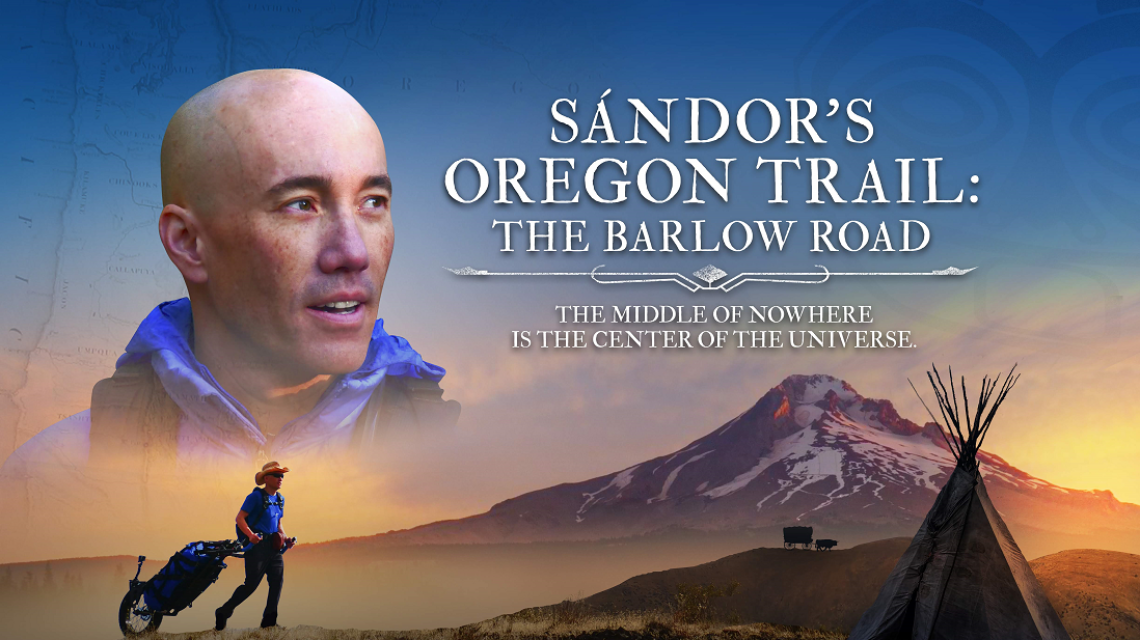Sándor’s Oregon Trail Channel on Vimeo
Sándor’s Oregon Trail Sizzle Reel
![]()
In Sándor’s Oregon Trail, writer and filmmaker Sándor Lau walks from Missouri to Oregon in the footsteps of the pioneers and the moccasins of native people. Without dying of dysentery.
On his journey through 2,000 miles of rattlesnakes, wildfires, and high-velocity lead poisoning, Sándor discovers the center of the universe in the middle of nowhere. Showcasing traditional skills used by emigrants on wagon trains and by indigenous people who belonged to this land long before the Great Medicine Road, this living history show rediscovers the American West as a place in our hearts more than a space on a map.
Sándor’s Oregon Trail at Alcove Spring
![]()
Pioneers on the Oregon Trail stopped to camp at Alcove Spring in northeastern Kansas. In this historic short documentary, filmmaker Sándor Lau introduces characters from the past. Joe Meek disproved rumors that the mosquitoes grew as large as turkeys. James Reed set out with his friends the Donner Brothers before they got stranded by snow high in the Sierra Nevada mountains of California where they did not have a party.
Sándor’s Oregon Trail: Chimney Rock
By the time the emigrants had reached Chimney Rock in what’s now western Nebraska, they’d completed about a third of their journey to Oregon. To be clear, this was the easiest third, and yet it was still no small accomplishment. Many had turned back before reaching here or died along the way. To reach here, emigrants had survived over 600 miles of baking sun, choking dust, rattlesnakes, infernal mosquitoes, disease, accidents; and let’s not forget the crushing, grinding boredom of walking 15-20 miles a day in leather boots with no cushions. And yet, once they reached here, they would travel another four miles round trip from camp just to see the glory of chimney rock up close. Of other historic note, the world’s largest ball of string was not an available tourist attraction at the time.
Sándor’s Oregon Trail on the Platte River in Nebraska
Water is life and for hundreds of miles across what’s today Southern Nebraska, the Platte river was the lifeline for emigrants on the Oregon Trail. Lewis and Clark had attempted to float a keel boat up the Platte without success. Emigrants used to joke that the platte was a mile wide and an inch deep, too thick to drink, too thin to plow. But the river gave them almost everything they needed, it showed them the way, it brought game to eat, it watered the animals. And when they ran out of whisky, they had to drink something.
Fred Hill, Confederated Tribes of the Umatilla Indian Reservation
Tribes like the Cayuse, Umatilla and Walla Walla were here long before there was an Oregon Trail and their lives were never the same afterward. Fred Hill of the Confederated Tribes of the Umatilla Indian Reservation talks about growing up with his tribal language taught to him by his grandmother and listening to coyotes tell things to come. Filmed on the Umatilla Reservation in Northwest Oregon on the prairie near Tamástslikt Cultural Institute.
Sándor’s Oregon Trail at the Guernsey Ruts, Wyoming
Hundreds of thousands of pioneer emigrants cut the Guernsey Ruts in the rock with their wagon wheels in what’s today Eastern Wyoming. Sándor explores the ruts and tells why this is the worst place to break down.
Sándor’s Oregon Trail on the Willamette River, Eugene, Oregon
Wherein are revealed secrets of ancient Oregon geography and how to catch fish with a frying pan on the Willamette River in Eugene, Oregon. Sándor also reveals how to collect gold using only a naked body and bottle of oil.
How to Make Mashed Potatoes with a Black Powder Rifle
Mountain men show Sándor how to make mashed potatoes using only black powder rifles. Filmed at the Fort Umpqua Muzzle Loaders event, Broken Wagon Rendezvous in Crow, Oregon.
Charcloth Demonstrates Flintlock Pistol
Mountain man Charcloth demonstrates the kind of flintlock pistol used when you got into a real scrape in the beaver trapping days. While flintlocks were outdated by the time of the Oregon Trail, many travelers used what they had.

